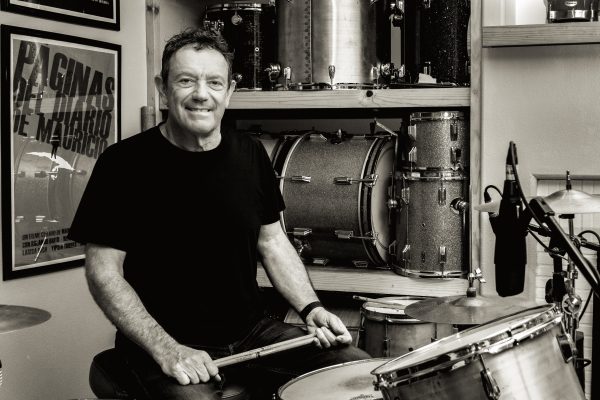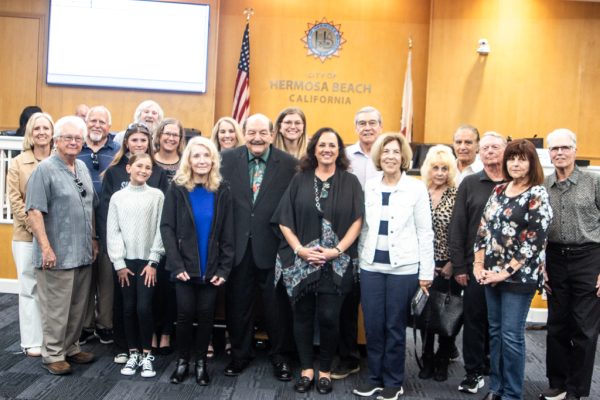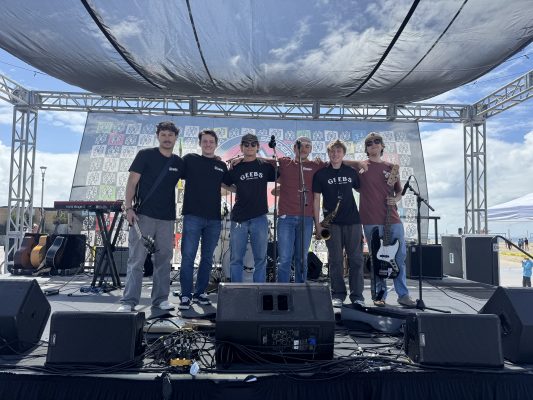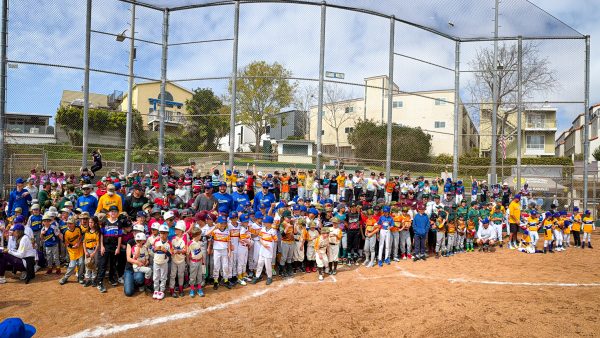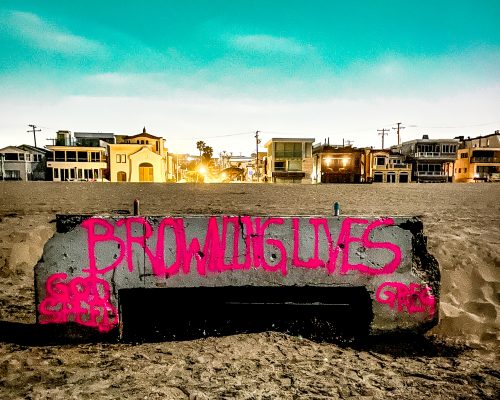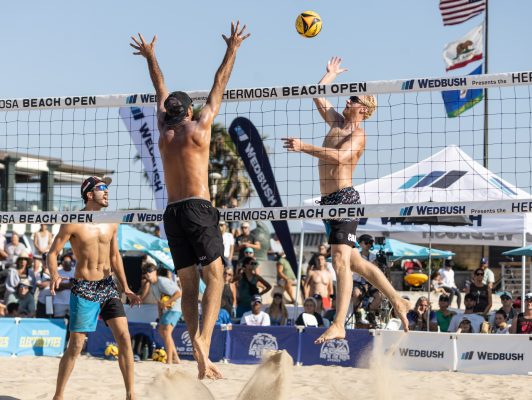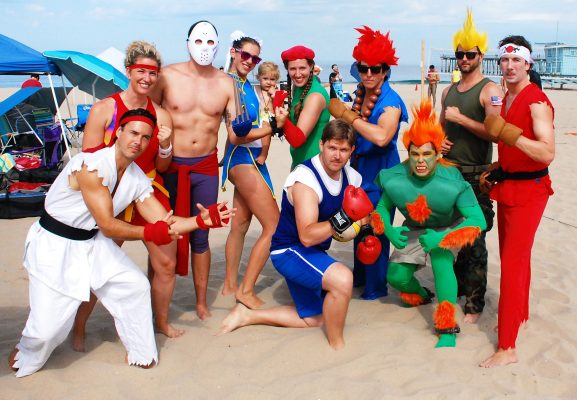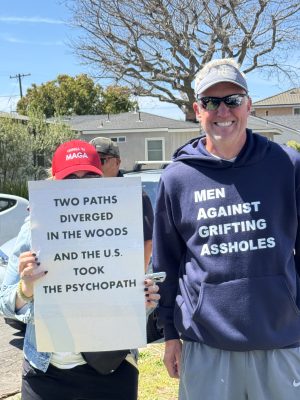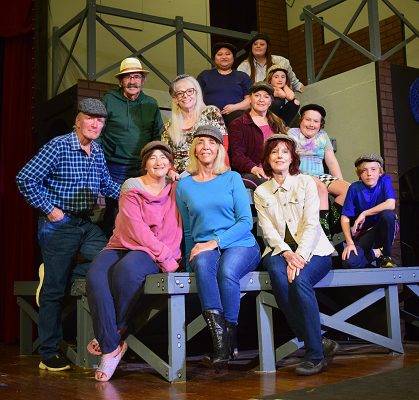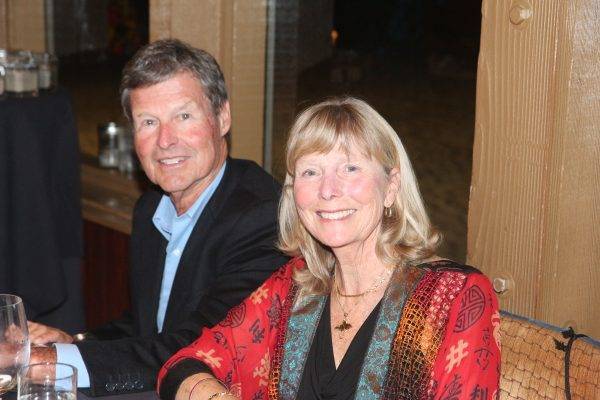by Kevin Cody
In 2001, Surfer’s Journal editor Steve Pezman invited Hermosa Beach surf photographer Mike Balzer to bring his portfolio to the magazine’s San Clemente office. The Surfer’s Journal founder and former Surfer magazine editor was planning a photo spread on South Bay surfers. But after viewing Balzer’s portfolio, Pezman spiked the idea.
Pezman hadn’t anticipated Balzer’s portfolio to include chiseled, tow-in pioneer Laird Hamilton at Off the Wall, Pipeline Masters champion Bruce Irons breaking a fin loose at Backdoor, and a camera-board shot of Rob Machado getting barreled on a board with Jimi Hendrix’s portrait.
On Saturday, April 27, Balzer will be installed in the Hermosa Beach Surfer’s Walk of Fame, along with longtime friend and collaborator Greg Browning, and Hawaiian surfer David Nuuihiwa
Labeling Balzer a South Bay photographer, Pezman recognized, was like calling Bob Dylan a folk singer. It wasn’t simply that his portfolio wasn’t provincial, but that it spanned the traditional, violence strewn divide between contest and soul or freestyle surfing.
The divide traces back to 1967 when rebel stylist Mickey “Da Cat” Dora advanced to the semi finals of the Malibu Invitational and then mooned the judges. Most people in surfing saw the divide as unbridgeable. Balzer recognized it as the crucible for surfing’s future and proved it with free surfing photos of World Championship Tour professionals, like Machado, and contest photos of feral surfers like Christian Fletcher. But Balzer didn’t merely document the revolutionary transition in surfing in the 1990s — from getting barreled to getting air. He helped instigate the revolution by encouraging top contest surfers to perform free of contest constraints.
The freestyle sessions he organized were primarily in the South Bay because that’s where he lived. The piers, sand berms and steep, ocean view streets provided the camera angles he needed. The Santa Ana winds and the early morning sun, unobstructed by tall buildings, gave him “golden hour” lighting. And the South Bay’s steep, fast waves provided the launch pads his surfers needed to break free of the wave’s two-dimensional surface.
The spring 2001 Surfer’s Journal carried 24 pages of Balzer photographs, the most the coffee table-format magazine had ever devoted to a single photographer’s work. They included three different surfers performing fin-free (out of the water) snapbacks at the Manhattan Beach pier in the late 1990s, a maneuver so revolutionary at the time that one, of Gre Browning, made a magazine cover and the others inside double spreads. Today snapbacks are a near compulsory contest maneuver.
The headline to the Surfer’s Journal spread was “Portfolio: Mike Balzer…By the Bootstraps.”
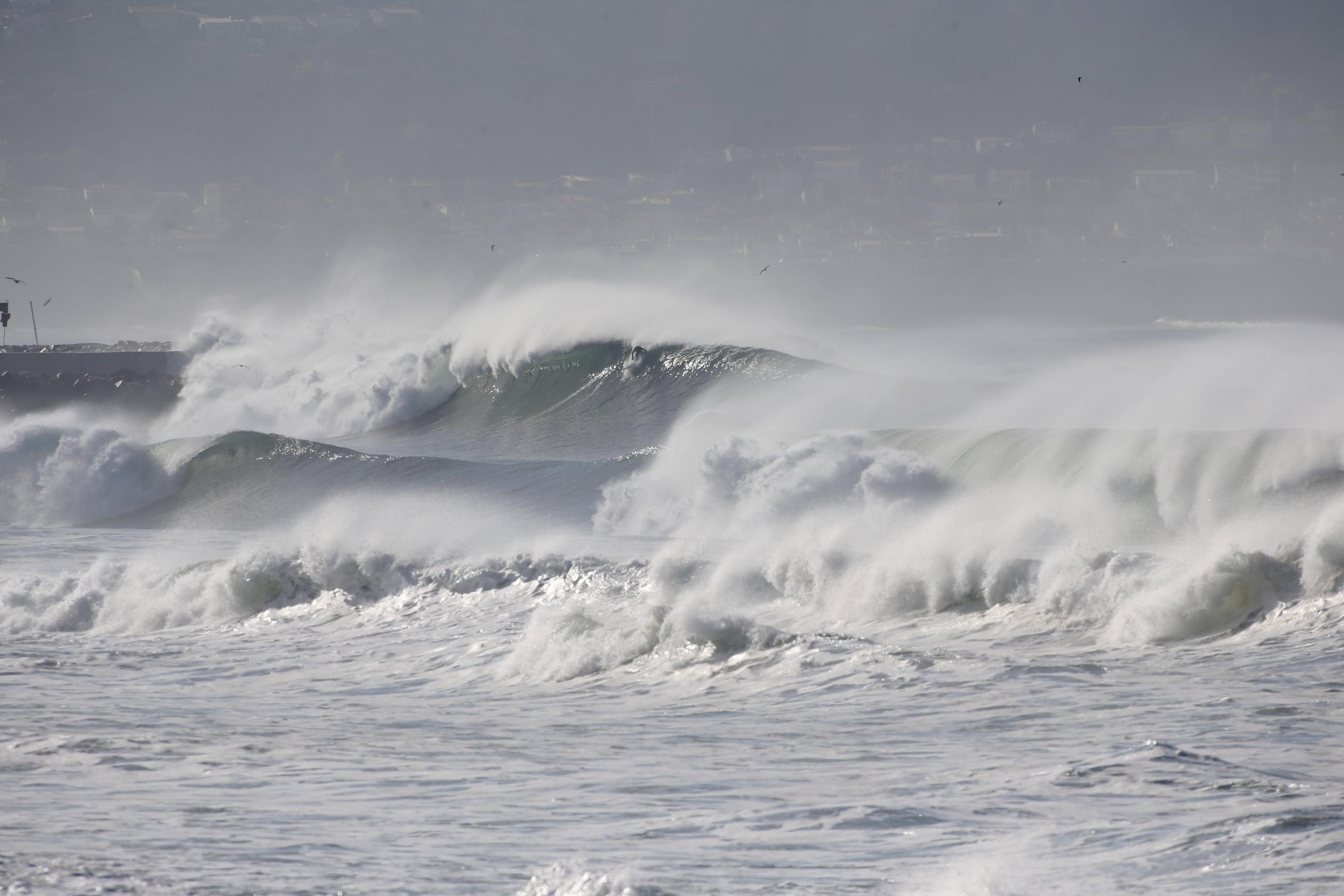
Just don’t call it a vacation
To his neighbors on 25th Street in Hermosa Beach, Mike Balzer is Dr. Plumeria. His lawn is lined with the tropical natives that most of the year look like a briar patch. But come summer the plumerias form a wall of color and scent that evoke warm breezes and mai tais. His whole block does. A front yard sign reads, “Come to the door and ask for a cutting. We will get it for you. Mahalo.” Neighbors have made liberal use of the invitation.
Balzer bought his first plumeria in 1995 from a local nursery that was throwing them out because the dormant plumerias looked dead.
“I bought them for their smell. It brings me back to Hawaii,” he said. The plumeria is so reminiscent of Hawaii it is popularly thought to be native to the islands, though it spread throughout the tropics from Central America.
His red blooming cuttings from Bali, where he went with Body Glove team surfers and former Peninsula High stars Alex Gray and Holly Beck, and Hawaiian surfers Kalani Robb, and Cheyne Magnusson
Plumerias are one of the perks that come with a job most people view as a perk in itself.
During the two week Bali trip Balzer stayed at Kuta Beach in a resort owned by the father-in-law of Rizal Taongon, Bali’s most famous surfer.
“You tell people you spent two weeks in Bali, or Hawaii, and people go, ‘Wow, you must have had fun.’ I’m not looking for sympathy, but if you did it, you’d know it is work,” he said.
“You try to be first down on the beach so you can shoot the arrival shot and you wait until the last surfer is out of the water to shoot the departure shots. Then you carry your cameras, tripods and lenses up the beach, which can be a long hike in soft sand, while the surfers are yelling to hurry up because they want to get back to the hotel to eat,” he said.
As evidence the trip was no vacation, the former competitive surfer noted that he didn’t surf once, even though it was his first trip to Bali’s world class waves.
He did concede, though, “If I won the lottery, I’d still be a surf photographer. It’s a disease.”
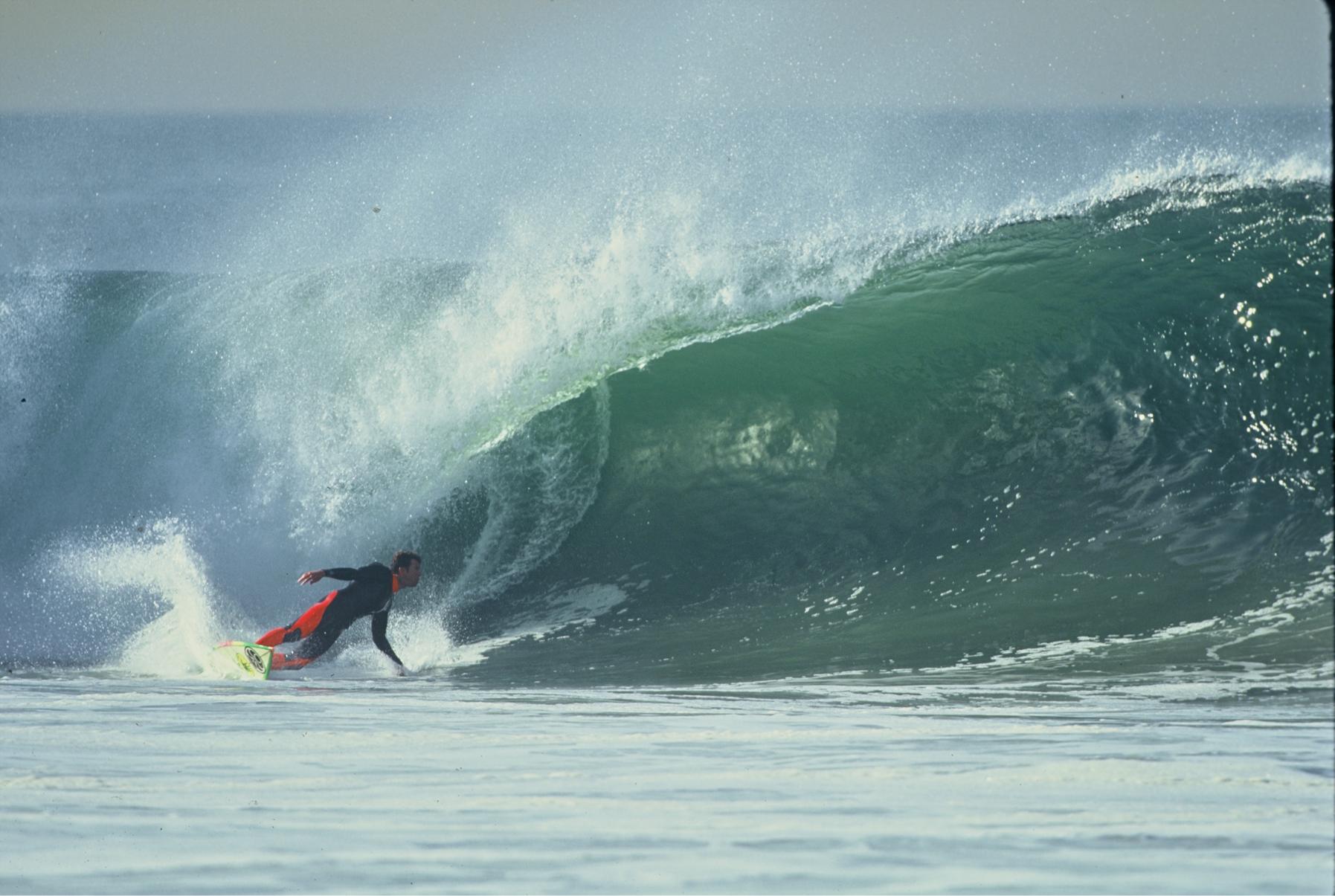
The incidental photographer
Like most top surf photographers Balzer is self-taught. He studied environmental design and real estate at San Diego State, where he enrolled to be close to the surf after graduating from Mira Costa High School in 1977.
“I bought my first surfboard in sixth grade for $125 from (former U.S. Surfing champion) Mike Purpus at Petrillo Surfboards on PCH. Mike threw in 25 bars of purple surf wax. For years, just the smell of surf wax scared me because I was so afraid of surfing when I got that board. During junior lifeguards, if a kid wanted to borrow my board. I’d say, ‘Go ahead,’ because then I could stay on the beach.”
During his Pier Avenue Junior High years he preferred riding dirt bikes, a diversion that decades later would pay unanticipated dividends. He and his 24th Street neighbor Gary Lane would ride their Honda 125s in the rabbit field that is now Manhattan Village Shopping Center. Builder Dave Garrett, the “Dad of 24th,” would take the neighborhood kids to Jawbone Canyon and to the track at Saddleback Park.
But 24th Street was also home to legendary surfboard shaper Phil Becker, who was shaping for Rick Stoner. Balzer’s father Jack, an Allstate Insurance agent, insured Stoner’s Hermosa Beach shop.
“I finally started surfing in eighth grade because motorcycle riding wasn’t cool. By high school, I was surfing year round with the 24th Street crew, which included Becker, John Croteau, Clem Camu and Gus and Guy Bergstrom. I’d bring all my high school friends to Rick’s Surf to order boards and we’d go to Phil’s shaping bay, which was like walking into Picasso’s studio. I brought Rick so much business that one day Rick’s air brusher Dave Hollander said to me, ‘Son, we’re going to give you a 20 percent discount.’ I thought that was really cool.” (Becker, Hollander and Rick’s glasser Steve Mangiagli would found Becker Surf in 1980, following Rick Stoner’s sudden death from a brain aneurysm.)
At San Diego State, Balzer joined the school’s surf team and placed third in the first contest he ever entered, a NSSA (National Scholastic Surfing Association) event at Black’s Beach.
By his junior year he was the top surfer at the perennial surf powerhouse. His teammates included fellow Hermosan Matt Warshaw and Warshaw’s roommate Bill Sharp. Ironically for them and fortuitously for the future surf photographer, Warshaw would become Surfer magazine’s editor and Sharp the editor of rival Surfing magazine. (Warshaw would also write The Encyclopedia of Surfing, while Sharp would go on to become director of the Billabong Biggest Wave contest. Another San Diego State teammate was Mark Theodore, who would use the nickname Balzer gave him as the name for his independent South Bay record label, Theologian Records.)
Despite his college contest success, Balzer had no illusions about a competitive surfing career.
“Ted Robinson from Manhattan Beach would kill us every time we competed, and unfortunately we were also surfing against guys like Mike Parsons and Tom Curren.”
(Parsons would win the Pro Surfing Association title in 1991 and the Big Wave Award in 2001 for riding a 60-foot wave at Cortes Bank. Curren went on to win world titles in 1985, 1986 and 1990.)
Nor did Balzer foresee a future in surf photography. His parents had given him a Pentax, the poor man’s Nikon, when he went away to college. But he saw photography as a tool to improve his surfing. “I wanted to document what could be done on a wave,” he said.
“It was easy to grab my camera on the way out the door and take a few shots if it looked good. If it looked really good, I’d ditch the camera and just go surfing,” he wrote in the story that accompanied his Surfer’s Journal photos.
By the time he graduated from San Diego State in 1983, he’d had only one photograph published, taken on an epic day from the cliff above Black’s. He sent it to a small magazine called Breakout because he didn’t think the more established surf magazines would publish him. Breakout gave the photo a two page spread and paid him in bragging rights.
After graduation, Balzer returned to Hermosa Beach to work as a beer salesman with Bay Distributors. His territory was West LA, which he found too high brow for his taste or his beer. “They’d tell me they wouldn’t serve Bud to their dishwashers,” he remembered.
“My parents grew up during the depression and to them a job was where you wore a suit and tie,” he said.
But it wasn’t his idea of a job. He quit the beer business after three years to work as a photographer for the Miss Universe Pageant.
One evening in 1983, he photographed the Manhattan pier with the 8th Street lifeguard tower in the foreground. A fire raging in Zuma intensified the sunset. Surfer bought the photo and ran it across two pages with a story on South Bay surfing.
That led to steady assignments from his old San Diego State teammate Sharp, who was now Surfing’s editor.
But the surfing assignments were sporadic and paid poorly, so he kept his Miss Universe job until one morning in 1988 when he photographed local surf star Chris Wells at the Avenues in Redondo Beach. After the session, Wells asked Balzer to stop at Body Glove. Wells needed to pick up an entry for a Bud Pro Surf contest at the Wild Rivers Water Park in Irvine.
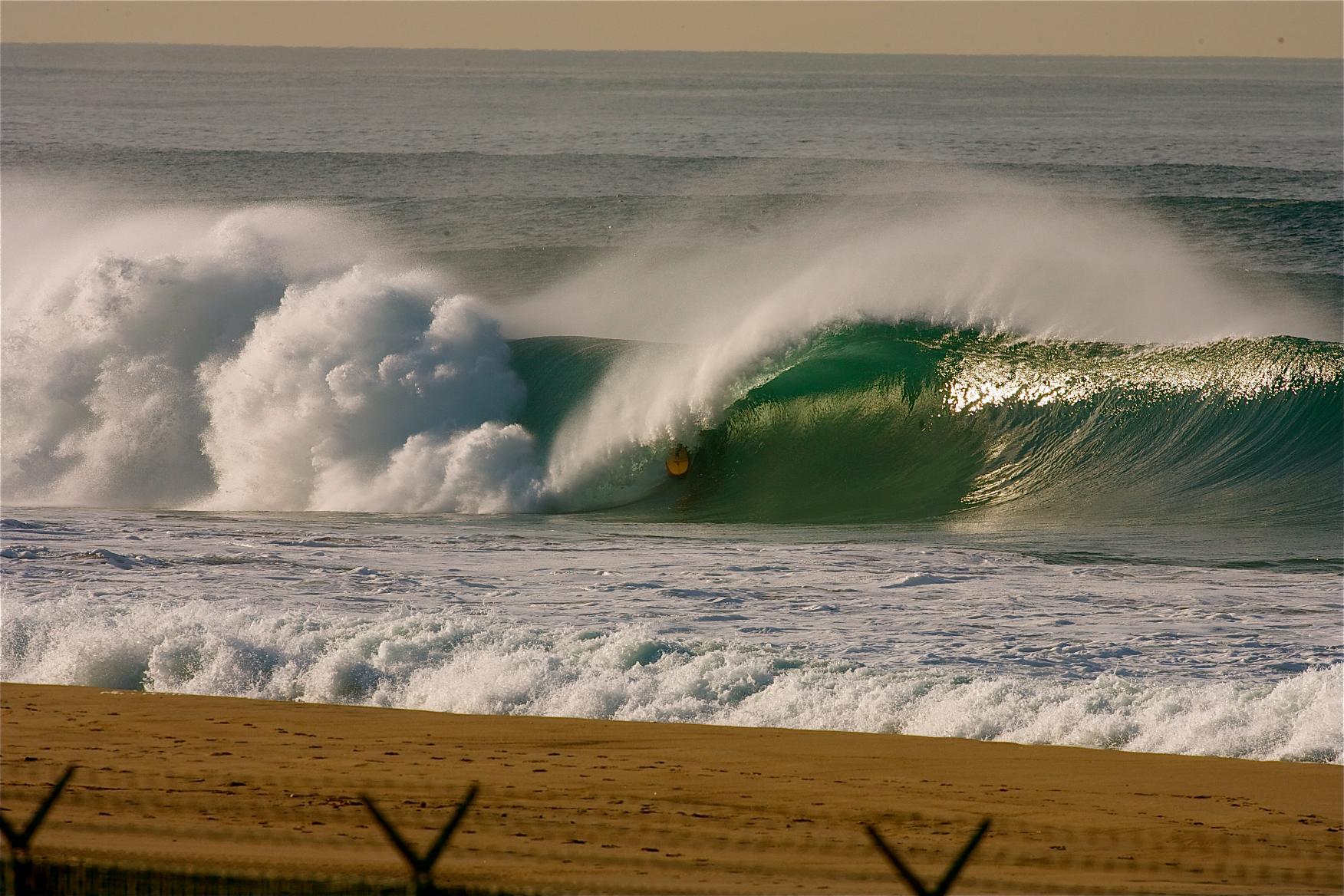
Joining the Body Glove family
Balzer left his Surfing magazine business card at the office for Body Glove president Robbie Meistrell. The next day Meistrell called to ask Balzer to shoot the water pool contest.
Balzer’s photo from the contest of future nine-time world champion Kelly Slater scored the cover of Surfing.
Meistrell was sufficiently impressed to offer Balzer a full time position with Body Glove. Balzer accepted, even though it meant begging off an assignment to photograph the Miss Universe contest in Taipei the following week. He said it was an easy call.
“I was looking to bring our photography in-house because I wanted to own the photos. We had been using freelancers who kept the rights,” Meistrell said.
Balzer secured his place in the Body Glove family one day at Jocko’s in Hawaii.
“The surf was so big that everywhere else on the North Shore was closed out,” recalled Meistrell. “I caught some smaller waves and then this macking set came in and Scott Daley (Body Glove’s marketing director) yelled at me to ‘whip it’ as I was scrambling up the face. So I did, and when I got to my feet I remember thinking, ‘Oh my God, I can’t believe I did that.’ I rode it all the way to the beach and I didn’t want to go back out. So I walked up to Balzer, who was shooting from the shore and yelled at him, ‘Did you get that?’”
Three oversize prints of the wave line the entryway to Meistrell’s home on the 11th hole of the Arnold Palmer Golf course in La Quinta.
“This was my dream job at a time when there weren’t many full time surf photography jobs,” Balzer said. “More than anyone except my family, they’ve helped me get to where I am today. I had been doing assignments with rented lenses from Samy’s in Hollywood. Body Glove enabled me to buy my own equipment. My first big purchase was an 800 mm lens and a Canon F1 body with a motordrive and a big viewfinder that you could see through with sunglasses on.”
Balzer’s Body Glove responsibilities included photographing the Budweiser U.S. Pro Surfing Association contests. Body Glove had bought the PSA from founder Joey Buran. The California tour was meant to be a stepping stone to the WCT, but with its Prime Time cable contract and $500,000 in prize money, pro surfers began defecting to the Bud Tour from the WCT, which offered less prize money and didn’t have a TV contract.
“The surf manufacturers all thought you had to have a pro representing your products on the World Tour. But the pros were never around for appearances or ad shots because they were traveling the world. We were paying Australian pro Glen Winton $1,500 a month and couldn’t get him to pose for a wetsuit photo. And for most of the pros, the sponsorship money wasn’t enough to cover their expenses. Our tour kept the pros home and cut down on their expenses,” Meistrell explained.
“In 1989,” Balzer recalled, “Robbie decided to put up $30,000 for the season’s final event. It was the biggest first place prize in surfing’s history. WCT’s biggest prize was $20,000.
“We got a permit for Lower Trestles, and had Surfline’s Sean Collins pick the best wave window for the week-long event,” Balzer said. “It got so much attention that the president of (apparel maker) OP called and asked to enter Tom Curren, who was the world champion. Robbie said okay, but to be fair to the guys on the tour, Curren would have to start in round 1. The tour’s top point earners were seeded in round 3. OP wouldn’t agree and Robbie wouldn’t back down.”
Christian Fletcher ended up winning with his innovative, aerial pyrotechnics that would, like the photos Balzer had been taking in the South Bay, help change how surfers surfed and contests were judged.
“No one on the WCT, not even Curren, was doing aerials then,” Balzer said.
One of Balzer’s favorite surfers during this period was Rob Machado.
One day he told Surfing’s mercurial photo editor Larry “Flame” Moore that he should keep an eye on this rising young NSSA surfer from Cardiff. Moore thought Balzer was pushing Machado because Machado surfed for Body Glove, and ignored the advice, only to see Machado win the Bud Pro tour in 1993 and show up on the cover of his bitter rival Surfer.
But Surfing printed plenty of other Balzer photos in what Balzer described as a mutually beneficial arrangement.
Surfing got free photos, Body Glove got free publicity, and Balzer benefited from Flame’s mentoring. In time, Balzer developed a reputation for tack sharp focus and speed blur photos. One year, Moore presented Balzer with a Golden Flame Award for Best Speed blur for a shot of free style surfer Dan Malloy at Rocky Point.
When Flame finally gave Machado a cover in 1994, it became one of the most memorable covers in surf magazine history.
Balzer had been working on camera boards with Spyder Surf shaper Dennis Jarvis and Redondo Beach artist Ted Vetterlein.
After years of trial and error, using South Bay surfer Greg Browning as his test pilot, Balzer figured out where to mount the camera, where to pre focus the lens and how to rig a radio controlled shutter release that he could trigger from the beach.
“I asked Rob to come up with art for the deck of the board and he suggested Jimi Hendrix because Rob plays the guitar. Vetterlein had to look through a fisheye lens as he airbrushed the portrait to compensate for the camera lens’ distortion,” Balzer said.
“We flew with the board on a private plane to Isla Natividad. This was before digital cameras, so you could only get 36 shots from a roll. Rob and Taylor Knox, who was with us, fired off 15 shots messing around with self portraits.
“Fortunately, conditions were perfect, and we got some keepers.
“After processing the film I showed it to Rob and Taylor, and they were blown away. Then we walked into Surfing and said to Flame, ‘Here it is, your cover.’ He looked at the photos and said, ‘Nice.’ That was it.
“We walked out in shock. Time went by and one day the magazine arrived in the mail and we had the cover and 14 pages from the trip on the inside.”
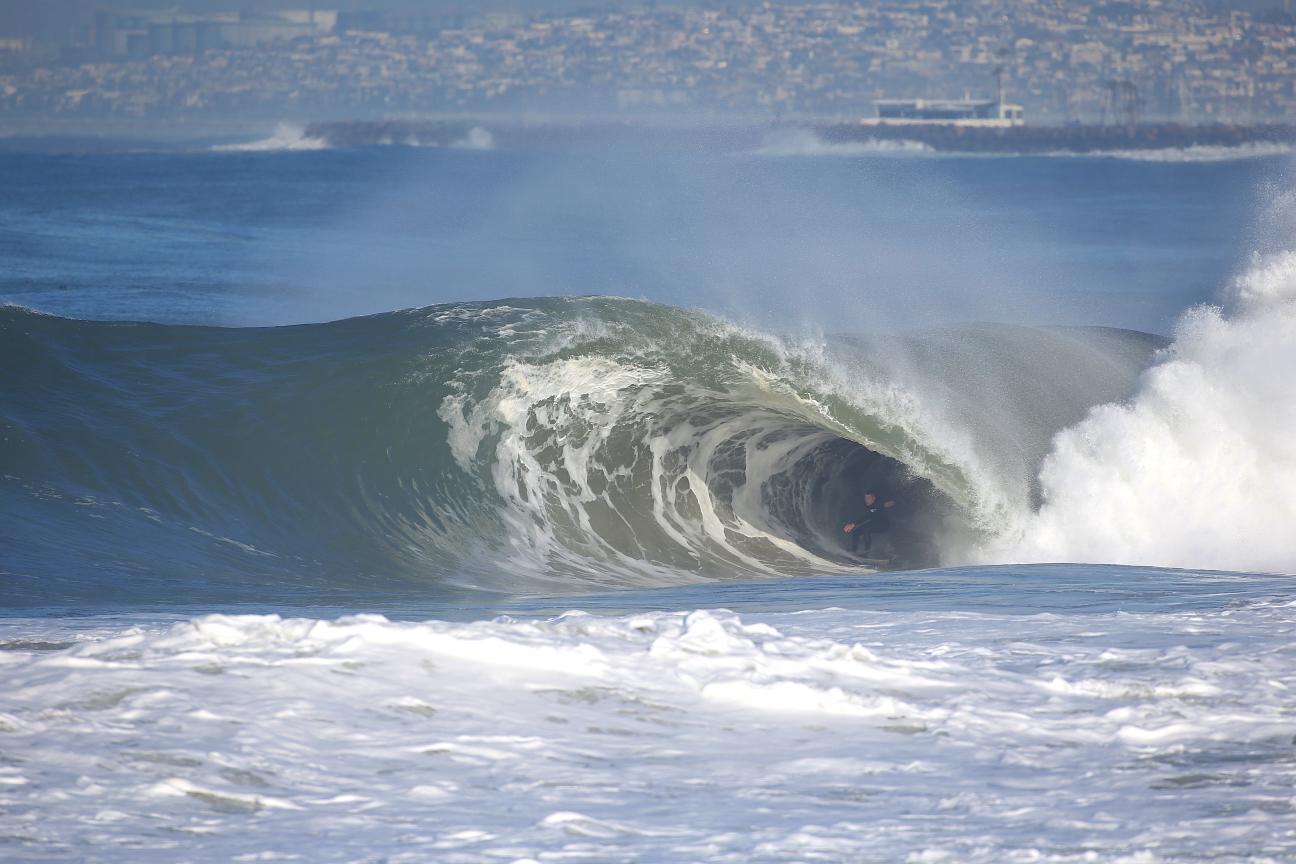
Flaming out
In 1993, Body Glove sold the Bud Tour to Prime Sports and Balzer lost his dream job. A year later Budweiser pulled its support and the tour collapsed
“Robbie Meistrell was ahead of his time,” Balzer said. “Proof of his concept is the guys he helped make the transition from amateur NSSA contests to the WCT. They included Kelly Slater, Machado, Shayne Beshne, Taylor Knox, Shea Lopez and Pat O’Connell.
“But the rest of the surf industry wouldn’t support him because they didn’t want to help a competitor, even though Body Glove was a separate entity.”
Meistrell remembered offering sponsorship of a contest to apparel maker Gotcha for one dollar just to get them involved. They turned him down.
In June 1995, Balzer switched his allegiance from Surfing’s Flame to Surfer photo editor Jeff Devine.
It was an emotional break, but the student felt he had outgrown his teacher and was finding the loyalty Flame demanded oppressive.
“With Flame, if you switched to Surfer it was like going over to the devil,” Balzer said.
The breaking point came following an expression session at a Bud Pro contest in Santa Cruz.
“Jason ‘Ratboy’ Collins was doing aerials that had never been documented before. I gave my photos to Surfer and they printed them as a two page fold-out. When Flame saw it, he lost it. I had to tell him my first responsibility was to the Bud Tour, and he knew that.
“The aftermath was all out war. Flame would call South Bay photographers and assign them to poach on my shoots. It’s like going to a party and not bringing beer, or girls. Most of the photographers wouldn’t do it. They’d call to tell me what Flame was up to.”
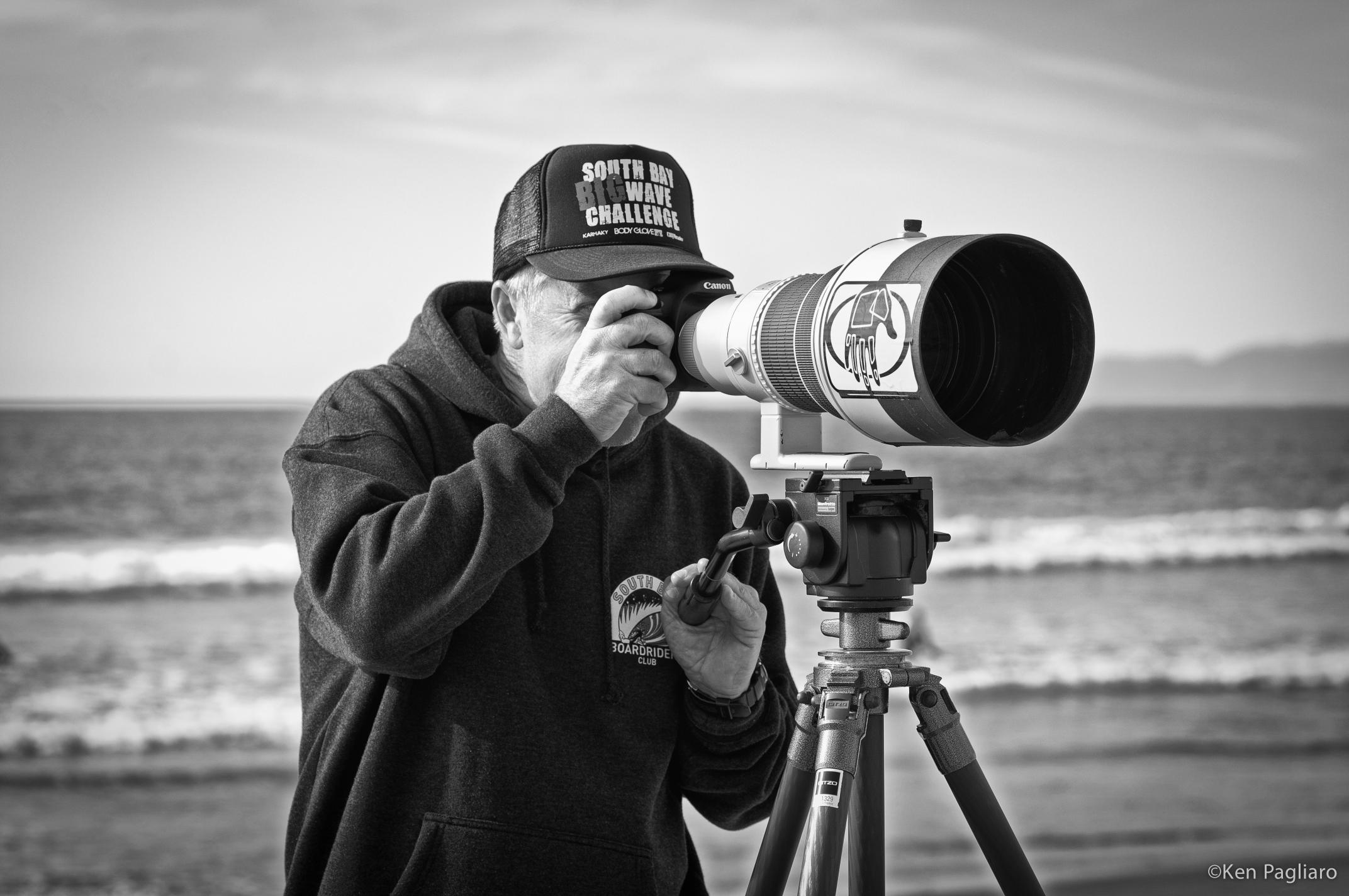
Mike Balzer with his preferred long, fixed lens, March 2019. Photo by Ken Pagliaro (KeinPagilaro.com)
The golden years
At Surfing, Balzer found a new mentor in Aaron Chang.
“Aaron was the standard everyone else was measured by. He did everything well – land shots, water shots, portraits, scenics. He had no weaknesses,” Balzer said.
In Balzer, Chang saw a work ethic uncommon in their field and enlisted him as an assistant.
“Mike had tenacity, drive and a sense for being in the right spot. But what I remember about him most was his sense of humor and positive attitude in the face of sometimes huge obstacles,” Chang said.
One of their most memorable jobs together, Balzer said, involved a fashion shoot in the dolphin pool at Knott’s Berry Farm.
“The plan was for my brother Todd and me to sit in the pool on surfboards while a trainer standing on a 600 pound dolphin and its 300-pound baby circled us. They made one lap and then the trainer jumped out of the pool and yelled at us to get out as fast as we could.
“We set up the shot one more time and then the trainer said, ‘We’re done. I don’t think they like you.’ Later in the day, a lady tried to pet one of the dolphins and it bit her.”
“The dolphins were smart. They wanted the job done in two takes and that was it,” recalled Chang.
Balzer’s first solo assignment from Devine was in Puerto Escondido, the Mexican Pipeline, with number three ranked Corey Lopez of Florida. The trip scored Lopez and Balzer their first Surfer cover.
Balzer’s early career covered what is today recognized as the golden age of surf photography. Manual cameras required years to master and the great photographers’ styles were as distinctive as great artists’ paintings. Palos Verdes native Jim Russi was known for his exquisite lighting, Chang for his versatility and perfectionism, Divine for his water shots and Balzer for sharp focus, blurs and camera board shots.
The transition from film to digital photography both democratized and debased the craft. Auto exposure, autofocus and instant playback made it possible for just about anyone to take a good photograph. Like monkeys at a typewriter, it might require hundreds of tries to get a printable result. But unlike 36 exposure film rolls, digital camera cards have nearly limitless capacity.
“With digital, you don’t need experience. If you mess up, you save the photo in Photoshop,” Balzer said.
Balzer said he reluctantly switched from film to digital because publications, which once insisted on slide film instead of negative film because of slide film’s superior sharpness and color, now insist on digital photos.
“The primary reason is speed. Magazine editors and marketing directors want photos sent yesterday,” Balzer said. “You can shoot digital in the morning in Bali and have the images in California before noon.”
Back to Body Glove, and the future
In 1997, Balzer was at the Santa Monica pier for the premier of a surf film when he said to a friend that he was going to marry the dark haired girl they were admiring across the room.
“I don’t know why I said it. But when I walked up to the bar Nick Christianson, whom I knew from NSSA, introduced us. She was with her parents and I’d just had my hair buzzed and was going to South Africa the next day, so I wasn’t interested in meeting anyone. Which is probably why I was so relaxed talking to her. I sent her some postcards from South Africa and called her when I got home.”
Three years later Balzer and Mishell, a physical therapist, were married and he decided to cut back on traveling to spend more time with his children Shane, and Malia.
Staying close to home gave him time to resume motocross riding.
“One day at a track in San Bernardino, I pulled my helmet off and shook out my hands and a guy runs up to me and says, ‘What the hell are you doing here?’ I said, ‘Who are you?’ He took off his helmet and it was Mike Parsons. He was sponsored by Arnett sunglasses and said I should be shooting their ads.
“He lined me up to shoot Steve Lamson, the number one guy in the 125 class, at the Honda test track. It was an ad for Fox, which makes motocross apparel and accessories. Because I rode I understood the culture and they started sending me more work.”
“One day I got a call on my message phone asking my day rate to shoot Jeremy McGrahy, who is the Michael Jordan of motocross. He’s the guy who sells out Anaheim stadium.”
Balzer’s work for Fox led to him becoming a regular contributor to Racer X, a new, fast-growing bible of motocross.
Then, as his motocross career was taking off, an old surf friend lured him back to Body Glove.
During Balzer’s first round with Body Glove, one of his favorite surfers was an enthusiastic, squeaky-voiced, 90-pound 13-year-old and rising NSSA surfer named Greg Browning.
“Our first session at the Redondo Avenues got Greg a photo in Surfing’s annual calendar. After that, he’d call every night and say, ‘Let’s look at it in the morning.’”
Their relationship led to Browning’s first Surfer magazine cover, in August 1997, taken at the Manhattan Beach pier.
“Before Greg knew he had made Surfer’s cover, I blew it up huge, mounted it on foam core and had all his friends sign it. Then I hung it over our fireplace and invited him over for a party. He freaked when he walked in.”
Despite growing up walking distance from the Manhattan pier, Balzer had never shot from the pier until Browning suggested it on a day the two were leaving El Porto.
“The surf at the pier was just as bad as El Porto, but I saw from the angle the sun hit the water on the north side that it would be a good place to shoot from,” Balzer said.
Balzer would score three Surfer cover shots from the pier – the one with Browning, one with Ventura surfer Keoni Cuccia breaking his fins loose, and one with Huntington Beach pro Jeff Deffenbaugh inside a tube with the focus so sharp that the blues of his eyes can be seen.
“I’ve had a lot of photographers ask me how I got that photo so sharp, but I have to keep that one a secret,” Balzer said. SWOF/ER


